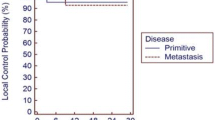Abstract
Background
Evaluate the safety, toxicity and efficacy of an institutional-simplified SBRT protocol with two short SBRT regimens (three or five fractions) for the treatment of lung cancer and oligometastases, according to the volume and localization of tumours.
Methods
Patients with stage I (T1 or T2) non-small cell lung cancer or lung oligometastases were treated from August 2011 to October 2015. Patients were required to be considered medically inoperable and were discussed in a multidisciplinary team.
Results
100 patients were analysed, 59 had a peripheral location (P), and 41 a central location (C).All patients finished their SBRT course without interruptions related to acute toxicity. The most frequent acute toxicity was grade 1 asthenia, only one patient developed grade 3 toxicity (pneumonitis) and there were no grade 4 or 5 acute toxicities. Three asymptomatic radiation-induced rib fractures were identified, the 1 and 2-year rib fracture-free survival were 97% and 94%, respectively. Two-year progression-free survival and 2-year overall survival of all patients were 52% and 70%, respectively, with a median PFS and OS of 26 and 43 months. Survival free of local progression (SFLP) at 2 years was 89%. A higher PFS in primary lung cancer compared with metastatic tumours was observed, with a median of 35 months with 19 months (p = 0.01). However, no statistical difference was observed in terms of OS between both diseases.
Conclusions
SBRT in lung cancer with three sessions for peripheral tumours and five sessions for central tumours may be safely delivered, with low morbidity.
Similar content being viewed by others
References
Mery CM, Pappas AN, Bueno R, Colson YL, Linden P, Sugarbaker DJ, et al. Similar long-term survival of elderly patients with non-small cell lung cancer treated with lobectomy or wedge resection within the surveillance, epidemiology, and end results database. Chest. 2005;128:237–45.
Raz DJ, Zell JA, Ou SH, Gandara DR, Anton-Culver H, Jablons DM. Natural history of stage I non-small cell lung cancer: implications for early detection. Chest. 2007;132:193–9.
Lo Simon S, Fakiris Achilles J, Chang Eric L, Mayr Nina A, Wang Jian Z, Papiez Lech, Teh Bin S, McGarry Ronald C, Cardenes Higinia R, Timmerman Robert D. Stereotactic body radiation therapy: a novel treatment modality. Nature. 2010;7:44–54.
Sahga A, et al. The Canadian association of radiation oncology scope of practice guidelines for lung, liver and spine stereotactic body radiotherapy. Clin Oncol (R Coll Radiol). 2012;24(9):629–39.
Timmerman R, Paulus R, Galvin J, Michalski J, Straube W, Bradley J, et al. Stereotactic body radiation therapy for inoperable early stage lung cancer. JAMA. 2010;303:1070–6.
Radiation Therapy Oncology Group-RTOG 0236. A Phase II trial of stereotactic body radiation therapy (SBRT) in the treatment of patients with medically inoperable stage I/II non-small cell lung cancer. https://www.rtog.org/members/protocols/0236/0236.pdfen.
Timmerman R, McGarry R, Yiannoutsos C, et al. Excessive toxicity when treating central tumors in a phase II study of stereotactic body radiation therapy for medically inoperable early-stage lung cancer. J Clin Oncol 2006;24 4833– 4839.
Asai K, Shioyama Y, Nakamura K, et al. Radiation-induced rib fractures after hypofractionated stereotactic body radiation therapy: risk factors and dose-volume relationship. Int Radiat Oncol Biol Phys. 2012;84:768–73.
Okoukoni C et al. A cortical thickness and radiation dose mapping approach identifies early thinning of ribs after stereotactic body radiotherapy. Radiother Oncol (2106), https://dx.doi.org/10.1016/j.radonc.2016.03.023
Bral et al. Prospective, risk-adapted strategy of stereotactic body radiotherapy for early-stage non–small-cell lung cancer: results of a phase II trial. Int J Radiation Oncol Biol Phys. 2011; 80(5):1343–9
Radiation Therapy Oncology Group-RTOG 0813. Seamless phase I/II study of stereotactic lung radiotherapy (SBRT) for early stage, centrally located, non-small cell lung cancer (nsclc) in medically inoperable patients. https://www.rtog.org/members/protocols/0813/0813.pdfen
Onishi H, Shirato H, Nagata Y, et al. Hypofractionated stereotactic radiotherapy (HypoFXSRT) for stage I non-small cell lung cancer: updated results of 257 patients in a Japanese multi-institutional study. J Thorac Oncol. 2007;2:S94–S100.
Hurkmans CW, Cuijpers JP, Lagerwaard FJ, Widder J, van der Heide UA, Schuring D, Senan S. Recommendations for implementing stereotactic radiotherapy in peripheral stage IA non-small cell lung cancer: report from the quality assurance working party of the randomised phase III ROSEL study. Radiation Oncol (Lond Engl). 2009;4:1. https://doi.org/10.1186/1748-717X-4-1.
Radiation Therapy Oncology Group-RTOG 0618. A Phase II trial of stereotactic radiation therapy (SBRT) in the treatment of patients with operable stage I/II non small cell lung cancer. https://www.rtog.org/members/protocols/0618/0618.pdfen.
Coroller TP, Mak RH, Lewis JH, Baldini EH, Chen AB, et al. Low incidence of chest wall pain with a risk-adapted lung stereotactic body radiation therapy approach using three or five fractions based on chest wall dosimetry. PLoS One. 2014;9(4):e94859. https://doi.org/10.1371/journal.pone.0094859.
Neal E. Dunlap, M.D et al. Chest Wall volume receiving %3e 30 Gy predicts risk of severe pain and/or rib fracture after lung stereotactic body radiotherapy. Int. J. Radiation Oncology Biol Phys. 2010; 76(3): 796–801
Song et al. Fractionated stereotactic body radiation therapy for medically inoperable stage I lung cancer adjacent to central large bronchus. Lung Cancer. 2009; 66(1):89–93
Milano MT, Zhang H, Usuki KY, Singh DP, Chen Y. Definitive radiotherapy for stage I nonsmall cell lung cancer. Cancer. 2012;118:5572–9. https://doi.org/10.1002/cncr.27589.
Fakiris A, McGarry RC, Yiannoustsons CT, et al. Stereotactic body radiation therapy for early-stage non-small cell lung carcinoma: four-year results of a prospective phase II study. Int J Radiat Oncol Biol Phys. 2009;7(5):677–82.
Acknowledgements
Not applicable.
Funding
This study received no any funding.
Author information
Authors and Affiliations
Corresponding authors
Ethics declarations
Conflict of interest
The authors declare that they have no competing interests.
Ethics approval and consent to participate
This project has been approved by “Comité de ética de la investigación en Andalucía”, with code SBRT15 and internal code 0796-M1-16.
Additional information
Publisher's Note
Springer Nature remains neutral with regard to jurisdictional claims in published maps and institutional affiliations.
Rights and permissions
About this article
Cite this article
Román, A., Perez-Rozos, A., Otero, A. et al. Efficacy and safety of a simplified SBRT regimen for central and peripheral lung tumours. Clin Transl Oncol 22, 144–150 (2020). https://doi.org/10.1007/s12094-019-02119-6
Received:
Accepted:
Published:
Issue Date:
DOI: https://doi.org/10.1007/s12094-019-02119-6




